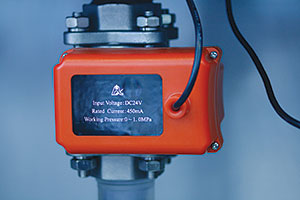Ceramic vs solenoid valves
August 2020
Valves, Actuators & Pump Control

Selecting the right valve goes beyond just understanding the application it needs to serve. It is also important to factor in cost efficiency, durability and maintenance considerations. In some cases, according to Lionel Maasdorp, MD at Allmech, switching from a solenoid valve to a ceramic ball valve can help to cut down on costs, while improving performance.
“Various industries, including water treatment and agriculture, make use of ceramic ball valves for a multitude of applications, usually where the demands on the valve exceed the capacity of conventional valve materials,” says Maasdorp. “The high-performance nature of ceramic valves means they often have a greater tolerance for wear, corrosion, and high temperatures than many other types of valves. However, even within the category of ball valves, there are different types available for specific purposes.”
For this reason, many Allmech clients are choosing to switch to ceramic ball valves from solenoid valves where possible. While the diaphragm in a solenoid valve may collect dirt as liquid moves through it, ceramic ball valves do not have a diaphragm, meaning they are less prone to dirt build-up inside the valve.
Furthermore, in sensitive environments or where minimal wastage is an important operational requirement, ceramic ball valves can provide a better option as the design of the valve means the ball core and seat are precisely ground in a pair to ensure there is no leakage. In contrast, solenoid valves are prone to seepage and blockages and need to be closely managed for leaks.
Maasdorp says that ceramic ball valves are ideal for many water-related applications, including water saving systems, industrial automatic control systems, automatic small application sewage systems, environmental protection projects, water supply and drainage, food and water treatment, and irrigation systems.
The ceramic ball valve also has the advantage of small flow resistance, good corrosion resistance, good wear resistance and long lifetime, making it an excellent option for inclusion in an industrial system.
“Ceramic ball valves have many important factors that make them an excellent choice for robust applications,” concludes Maasdorp. “They are cost effective, low maintenance, durable and their self-balancing design lowers torque and makes for smoother operation.”
Further reading:
Duplex valve improves continuous production at Gauteng manufacturing facility
Valves, Actuators & Pump Control
In a recent installation at a Gauteng-based manufacturer of household and personal care products, Allmech provided a tailored water treatment solution to ensure a consistent supply of soft water for steam generation, an essential element in the client’s 24/7 production cycle.
Read more...
Ultra-durable stainless steel submersible pumps
Valves, Actuators & Pump Control
KSB Pumps and Valves has launched a rugged stainless-steel submersible pump range designed for deep borehole use and other demanding freshwater and saline pumping applications.
Read more...
New wastewater pump for local municipalities and industries
Valves, Actuators & Pump Control
The latest wastewater pump from KSB Pumps and Valves is making waves in the industry due to a host of new features that provide users with an ultra-durable long service pump with fewer blockages and a lower maintenance requirement than traditional pumps.
Read more...
The critical role of check valves in fluid systems
Valves, Actuators & Pump Control
In fluid power systems, the performance and reliability of the entire operation often hinge on components that are small in size but significant in function. Among these, the check valve stands out as a fundamental yet frequently overlooked element.
Read more...
ENERGYValves expands operations
Valves, Actuators & Pump Control
ENERGYValves is expanding its operations with a new facility in Cape Town. The new premises will significantly enhance the company’s capacity to serve the Cape Town market and surrounding areas.
Read more...
Pumps lead the way with advanced technology
Valves, Actuators & Pump Control
The KSB GIW MDX pump has consistently represented a major leap forward in mill duty applications, with KSB relying on customer feedback to improving the design continuously.
Read more...
Wireless leak detection valve
Valves, Actuators & Pump Control
Designed to prevent water leakage by automatically shutting off the water supply when a leak is detected, the Runxin F104 wireless leak detection valve is one of the latest offerings from Allmech.
Read more...
Ball valves and actuators optimise HVAC performance
Schneider Electric South Africa
Valves, Actuators & Pump Control
Schneider Electric offers the full range of innovative SpaceLogic and EasyLogic ball valves and actuators. These cutting-edge products are designed to optimise HVAC system performance, ensuring comfort and energy efficiency in commercial and residential buildings.
Read more...
Alfa Laval expands hygienic valve portfolio
Valves, Actuators & Pump Control
Alfa Laval is expanding its hygienic valve portfolio by introducing the Unique SSV pressure relief valve and the Leakage Detection butterfly valve, alongside new smaller sizes of the Unique Mixproof CIP and Unique Mixproof process valves.
Read more...
Preparing pump systems for adverse weather conditions
Valves, Actuators & Pump Control
As the severity of storms in South Africa increases, so has the rush of sediment-laden water become a major issue and a significant challenge for irrigation. When sediment levels rise to just 10 grams per litre or more, the risk of pump wear and dam silting increases dramatically.
Read more...


